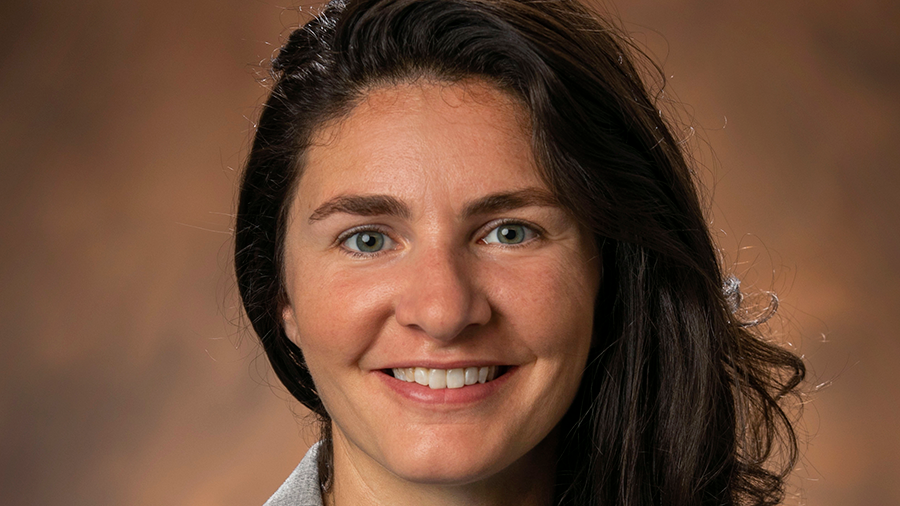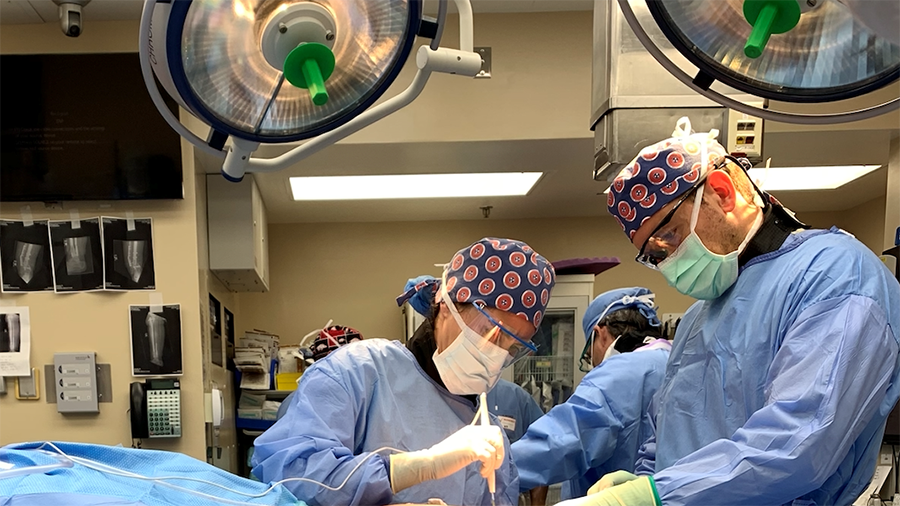Voices for change: Celebrating diversity within the AO
Lauren Tatman: My AO Access journey

An affinity for problem-solving led Lauren Tatman to a career as an orthopedic trauma surgeon, so it should come as no surprise that—as a member of the AO Access Officer and Faculty Selection Processes Task Force—she’s helping to find ways to ensure equitable access and opportunity for advancement within the AO.
An assistant professor of orthopedic surgery and assistant director of the orthopedic residency program at Washington University in St Louis (United States), Tatman grew up in a suburb of Cincinnati, Ohio, where she played sports in school and excelled in math and science. Education was important in her family.
“My father was the first one in our family to go to college. One generation back from him, most of my family was involved in blue-collar work: construction, steel factory work, and truck driving” Tatman says. “He grew up with my grandmother on the Pamunkey reservation in Virginia and moved away for college. He works in industrial sales and my mother stayed home with us. There was a lot of emphasis on opportunities associated with higher education growing up, and my interests in predominantly math and science led me to medical school.”
Playing soccer in high school and college (University of Dayton)—where she earned her bachelor of science degree in biology—taught Tatman the value of teamwork.
“One of my key takeaways from soccer was learning how to interact with a team,” she explains. “Sports can also serve as a microcosm for life: Understanding the balance and dynamics of failing and succeeding is critical to developing resilience.”
An assistant professor of orthopedic surgery and assistant director of the orthopedic residency program at Washington University in St Louis (United States), Tatman grew up in a suburb of Cincinnati, Ohio, where she played sports in school and excelled in math and science. Education was important in her family.
“My father was the first one in our family to go to college. One generation back from him, most of my family was involved in blue-collar work: construction, steel factory work, and truck driving” Tatman says. “He grew up with my grandmother on the Pamunkey reservation in Virginia and moved away for college. He works in industrial sales and my mother stayed home with us. There was a lot of emphasis on opportunities associated with higher education growing up, and my interests in predominantly math and science led me to medical school.”
Playing soccer in high school and college (University of Dayton)—where she earned her bachelor of science degree in biology—taught Tatman the value of teamwork.
“One of my key takeaways from soccer was learning how to interact with a team,” she explains. “Sports can also serve as a microcosm for life: Understanding the balance and dynamics of failing and succeeding is critical to developing resilience.”
When she was in medical school, Tatman found her interest in surgery.
“As I transitioned to the clinical years during medical school, I found myself enjoying my time the most on surgery rotations. I was initially leaning towards neurosurgery, but I spent a few days working with a female orthopedic trauma surgeon during my third year and the rest was history,” she recalls.
Her first orthopedic trauma surgery case was decisive.
“I just absolutely loved it,” she says. “What I didn’t realize was unusual at the time was that our staff surgeon was a woman and so was the resident. The scrub tech was male and he made a comment about it, but I didn’t pick up on what he meant until later on because I hadn’t seen another orthopedic surgery prior to that. What stood out about orthopedic trauma from the beginning was the high level of problem-solving for variable musculoskeletal injuries, the technical aspects of the cases, and the surgeon’s exceptional relationship with patients.”
There are underrepresented groups in orthopedics today—an issue that AO Access is working to improve on from within the AO, Tatman says.
“To truly represent the population we serve is a complex challenge. From the AO faculty perspective, the representation of surgeons being trained in our courses can differ based on their native country and culture,” she says.
Tatman feels fortunate to have trained at institutions with excellent female representation and mentorship.
“I have likely faced fewer diversity-related inequities and barriers than most. I have sought out training and work at institutions with great mentorship and leadership opportunities, but I’ve also been fortunate to have both male and female mentors invest a significant amount of time and energy in my professional development,” she notes.
And, just as she has had excellent role models, Tatman strives to be a good role model for the residents she trains.
“As a physician and surgeon, I have taken an oath to do the right thing for the patient regardless of any other extenuating circumstances. Training residents and fellows includes providing them with knowledge and a surgical skill set, but ultimately, they have to develop a moral compass that guides their behavior,” Tatman says. “We have to put our patients’ care above everything else, and we have to ensure that the trainees are prepared to do that as well when they move forward in their careers.”
While biases—often unconscious and subtle—do persist, she believes they are changing.
“As I transitioned to the clinical years during medical school, I found myself enjoying my time the most on surgery rotations. I was initially leaning towards neurosurgery, but I spent a few days working with a female orthopedic trauma surgeon during my third year and the rest was history,” she recalls.
Her first orthopedic trauma surgery case was decisive.
“I just absolutely loved it,” she says. “What I didn’t realize was unusual at the time was that our staff surgeon was a woman and so was the resident. The scrub tech was male and he made a comment about it, but I didn’t pick up on what he meant until later on because I hadn’t seen another orthopedic surgery prior to that. What stood out about orthopedic trauma from the beginning was the high level of problem-solving for variable musculoskeletal injuries, the technical aspects of the cases, and the surgeon’s exceptional relationship with patients.”
There are underrepresented groups in orthopedics today—an issue that AO Access is working to improve on from within the AO, Tatman says.
“To truly represent the population we serve is a complex challenge. From the AO faculty perspective, the representation of surgeons being trained in our courses can differ based on their native country and culture,” she says.
Tatman feels fortunate to have trained at institutions with excellent female representation and mentorship.
“I have likely faced fewer diversity-related inequities and barriers than most. I have sought out training and work at institutions with great mentorship and leadership opportunities, but I’ve also been fortunate to have both male and female mentors invest a significant amount of time and energy in my professional development,” she notes.
And, just as she has had excellent role models, Tatman strives to be a good role model for the residents she trains.
“As a physician and surgeon, I have taken an oath to do the right thing for the patient regardless of any other extenuating circumstances. Training residents and fellows includes providing them with knowledge and a surgical skill set, but ultimately, they have to develop a moral compass that guides their behavior,” Tatman says. “We have to put our patients’ care above everything else, and we have to ensure that the trainees are prepared to do that as well when they move forward in their careers.”
While biases—often unconscious and subtle—do persist, she believes they are changing.
.jpg?h=600&iar=0&w=600&rev=eaabaf65af90415b9d7880ad3e2b3160)
“Change will occur slowly and the first step is understanding that biases exist, and then changing systems to be more equitable.”
Lauren Tatman, MD
AO Trauma North America
AO Access Officer and Faculty Selection Processes Task Force
“A major goal for the AO Access Officer and Faculty Selection Processes Task Force is to develop a transparent, easily accessible application process with objective criteria across all clinical specialties,” she explains. “Equitable, fair application processes are in the best interest of minority and majority applicants as well as the organization. In comparison, application processes based on who the applicant knows instead of their experience and expertise will usually favor the majority group,” she explains.
The task force on which Tatman serves is seeking to track and understand whether AO faculty currently represent the learners at AO courses.
“An initial step for our task force is defining where we currently are, in order to understand where we can improve, or to identify if we are already well represented. We are working to develop objective data on the representation of our current faculty and our current learners,” she adds. “We also want to get more visibility for the faculty application process and make improvements in the transparency and objectivity of the faculty hiring practices. Being involved in AO Access, I’ve had the opportunity to gain more insight into the different solutions that everyone has; there’s no single, simple solution.”
Those insights are important because they can help the AO realize its mission of promoting excellence in patient care and outcomes in trauma and musculoskeletal disorders.
“A lot of decisions are made by physicians and surgeons for patients, and the more we reflect the general makeup of the patients, the better we can empathize and make decisions that are best for them,” Tatman says. “Most of our care is based on shared decision-making, but the more we can relate to our patients, the better care they get.”
The task force on which Tatman serves is seeking to track and understand whether AO faculty currently represent the learners at AO courses.
“An initial step for our task force is defining where we currently are, in order to understand where we can improve, or to identify if we are already well represented. We are working to develop objective data on the representation of our current faculty and our current learners,” she adds. “We also want to get more visibility for the faculty application process and make improvements in the transparency and objectivity of the faculty hiring practices. Being involved in AO Access, I’ve had the opportunity to gain more insight into the different solutions that everyone has; there’s no single, simple solution.”
Those insights are important because they can help the AO realize its mission of promoting excellence in patient care and outcomes in trauma and musculoskeletal disorders.
“A lot of decisions are made by physicians and surgeons for patients, and the more we reflect the general makeup of the patients, the better we can empathize and make decisions that are best for them,” Tatman says. “Most of our care is based on shared decision-making, but the more we can relate to our patients, the better care they get.”


